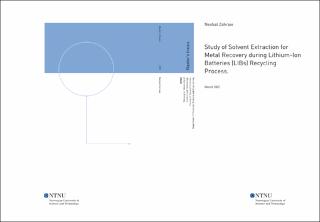| dc.description.abstract | Nowadays, the demand for electric vehicles (EVs) is rising, leading to an increase in the production of lithium-ion batteries (LIBs) since these batteries are used in EVs. A large number of Ni, Mn, Co, and Li resources are needed for the future production of LIBs, and this leads to future critical supply risks. The increasing demand for EVs will consequently represent a significant challenge regarding their status after reaching the end-of-life. The large amounts of spent LIBs need to be recycled effectively to minimize the environmental impact and help the industries move towards sustainable supply chains.
This thesis aims to study the extraction behavior of transition metals such as Mn from the leachates of spent LIBs using acidic extractant Bis (2-Ethylhexyl) phosphate (D2EHPA). The effect of equilibrium pH, extractant concentration, and initial concentration of metal ions on extraction efficiency were investigated. It was found that Mn can be selectively extracted from the leachates by D2EHPA with limited co-extraction of Co, Ni, and Li. With 10 vol% D2EHPA at the equilibrium pH of 3.5 and O/A=1, close to 90% of manganese was extracted with less than 7% co-extraction of Ni, Co, and Li. Although some Cu and Al were co-extracted with the Mn (low concentrations of Cu and Al, < 130 pm in the organic phase), these impurities can be eliminated with a proper scrubbing stage.
Furthermore, the extraction mechanism of Li from wastewater of spent LIBs wet-crushing step, by the combination of acidic (chelating) and neutral extractant was investigated. The β-diketone extraction system used in the experiment was composed of benzoyltrifluoroacetone (HBTA), trioctylphosphine oxide (TOPO), and kerosene. Lithium was extracted from wastewater by the β-diketone system with an extraction efficiency of 93% and higher. It can be concluded that the β-diketone system is suitable for Li recovery from wastewater streams of LIB recycling. | |
